Madrid Stormwater & Erosion Control Project News
Comment Period Extended–Madrid Stormwater & Erosion Control Project
09/10/2020 – The comment period for the Madrid Stormwater & Erosion Control Project Conceptual Designs is being extended two weeks, to September 24, 2020. We appreciate all the feedback we have recieved so far, and will post a summary once the review period closes.
Madrid Stormwater & Erosion Control Project: Conceptual Designs Now Available
08/10/2020 – The Abandoned Mine Land Program (AML) is pleased to announce a month-long review period for new conceptual designs for the Madrid Stormwater & Erosion Safety Project. These designs represent a significant step in the development of this project. To access the designs, click here or visit the Project Documents Page. Please submit any comments or questions to Jacob Pederson at jacob.pederson@emnrd.nm.gov before September 24, 2020.
What are conceptual designs?
- Conceptual designs guide project development by describing two realistic alternatives for addressing project goals and objectives for three project areas: Icehouse/Arroyo, Firehouse, and The Water Tank Project Area.
- Effective designs are broadly acceptable to residents, landowners, and other project partners. This is why we value your input!
- Conceptual designs do not show final locations for individual project features. For example, locations for diversion channels, sediment detention areas, and infiltration features continue to be flexible based on landowner preferences and specific site conditions as the project develops.
How were these designs developed?
- AML is the primary project developer with significant input from Santa Fe County Open Space, Trails and Parks Program; the Madrid Landowners Association; Madrid Water; NM DOT District 5; and dozens of Madrid residents and landowners.
- Public outreach resulted in landowners granting access to over 70 individual properties in Madrid for design and development of this project. Thank you!!!
- A community workshop and planned in 2018 to access continued community support systemic approach to addressing stormwater, flooding, and coal waste sedimentation issues in Madrid. A public meeting held later that year identified specific goals for each project area.
- AML contracted Weston Solutions, Inc., Riverbend Engineering, and Dekker/Perich/Sabatini to perform preliminary engineering and produce conceptual design sets.
- Santa Fe County Open Space contracted Riverbend Engineering to produce conceptual design sets for the Madrid Arroyo, which have been incorporated into the Icehouse Project Area of these new sets.
What are the next steps?
- AML will consider all comments and questions received from the public comment period and determination whether the alternatives described in conceptual designs are broadly acceptable to stakeholders and feasible to implement.
- Effective conceptual designs will be developed into technical plan sets.
- An environmental assessment (including cultural resources analysis) will be conducted for each alternative.
- In 2021, AML will continue to work closely with the Madrid community and other stakeholders to select preferred alternatives for each project area.
Recent Photos from Madrid
In late July consecutive 1-inch storms hit Madrid. These photos show some of the conditions that the Madrid Stormwater & Erosion Control Project seeks to address.
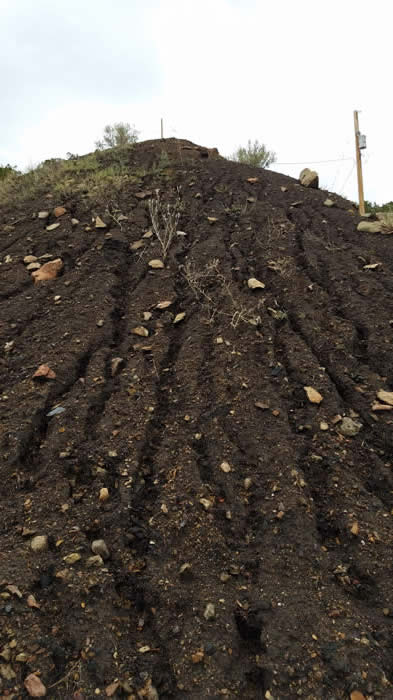
Madrid is unique, and the large historic coal waste piles that line the east slope are cultural features that add to Madrid’s character by evoking it’s history and attracting tourists and filmmakers from accross the country. However, the piles slowly erode with each storm. Shortly after rain events, small channels form across the surface of many piles, bringing coal-laden water into town and causing problems with roads, ditches, and basements. The Madrid Stormwater & Erosion Control Project conceptual designs present alternatives that help preserve piles in place by diverting stormwater around them, reducing the amount of water that passes through coal zones and therefore the amount of coal moving downhill in rain events.
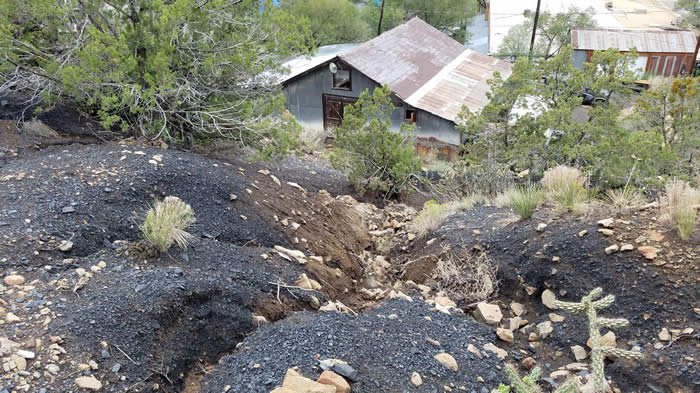
Water becomes more concentrated as it moves downhill, below the most prominant coal piles in Madrid. This leades to channelization through lower-slope areas above buildings and roads. Uncontrolled, this can become a hazard for residents and property owners. This photo shows an area below a large coal pile where surface reclamation can be a good option. Conceptual designs identify a few areas like this one where regrading the surface and establishing native plants can stabilize soils, hold back coal waste, protect private property, and keep driveways like Icehouse Road safer during storm events.
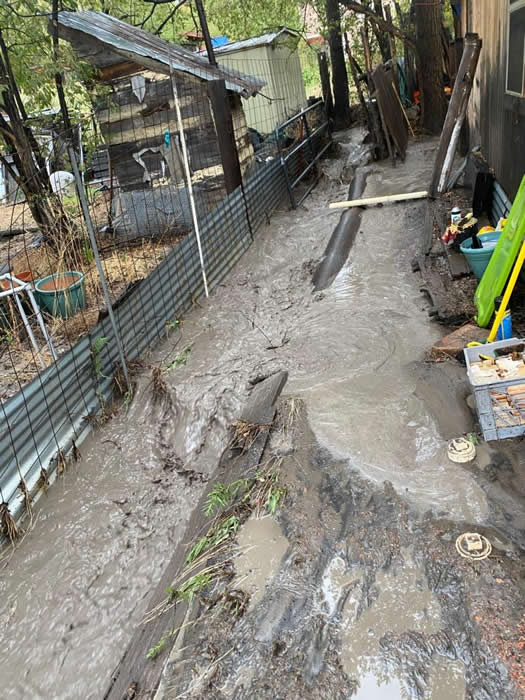
Throughout Madrid old stormwater channels like this one were installed by the mining company. In the many decades since mining ceased, most have sunken beneath the earth, leaving water to go where it will at the surface. Conceptual designs present options for rehabilitating sections of the old mining-era stormwater infrastructure to work for today’s needs. The property in this photo is in the path of old stormwater pathways that can be improved to help reduce local flooding on residential land near the Madrid Arroyo.
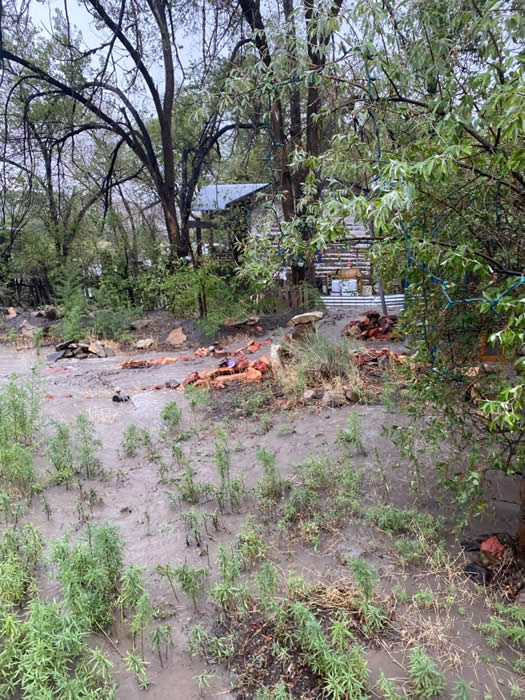
The flooding shown in the photo above is the result of stormwater moving downhill from the east slope of Madrid. Poor drainage and an old railroad grade prevent water from moving freely into the Arroyo. Working with the Santa Fe County Open Space, Trails and Parks Program, ALM has included in new conceptual designs an alternative for improving flood capacity and drainage in the Madrid Open Space property. This alternative would rebuild culverts on Arroyo Crossing Road, increase flood capacity in the Open Space property, and improve drainage on Cave Road.
Mining and Minerals Division Continues with Crucial Erosion Control Work in Madrid, August 2014
The Abandoned Mine Land Program is working to install permanent erosion control measures on and around historic coal mine waste piles in Madrid to protect local property and businesses from stormwater damage. In September 2013, Madrid was impacted by flood damage resulting from heavy rainstorms. In October 2013 MMD completed temporary stormwater protection measures and is now working on permanent installations.
Rangeland Hands, a contractor under the direction of MMD, is currently working to stabilize areas at the most heavily impacted area along the east slope of town. Workers are installing rock-lined channels and drop structures and will replace temporary concrete Jersey barriers with architectural precast concrete barriers for erosion control and storm water diversion.
The improvements to minimize storm damage by water run-off are federally funded by the Office of Surface Mining Control and Reclamation Enforcement (OSM) through the state’s AML Program. This phase of construction is expected to cost $600,000.
In conjunction with residents, property owners and civic organizations, the AML Program is evaluating options to stabilize additional hill slopes and drainages and direct storm flows away from homes and businesses.
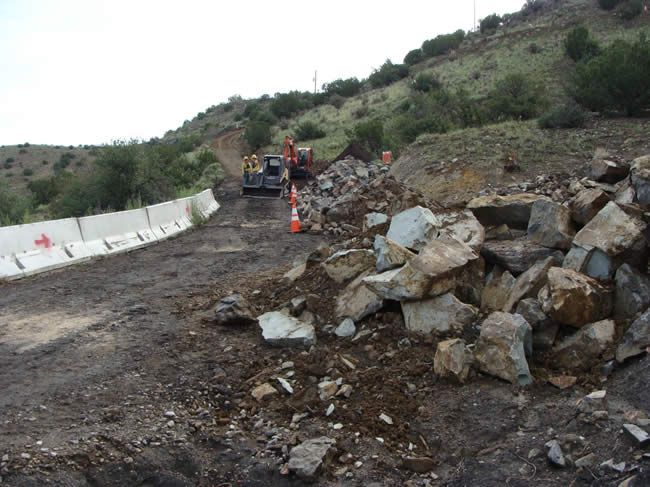
Rock waiting to be placed in channels. The temporary Jersey barriers on the left will be replaced with architectural precast concrete units.
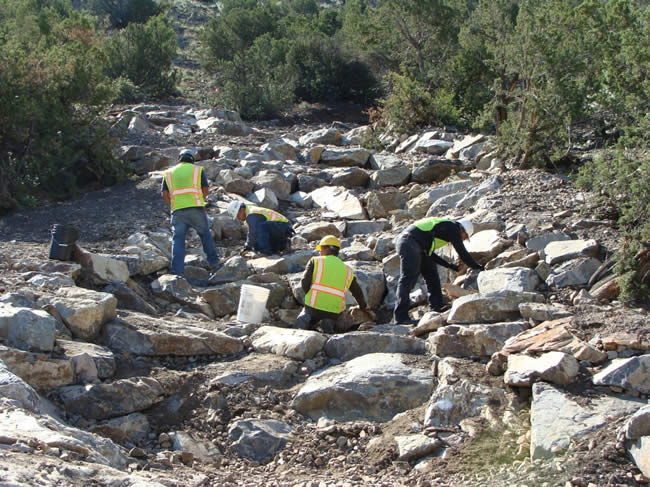
Hand fitting small rock into a large rock drop structure
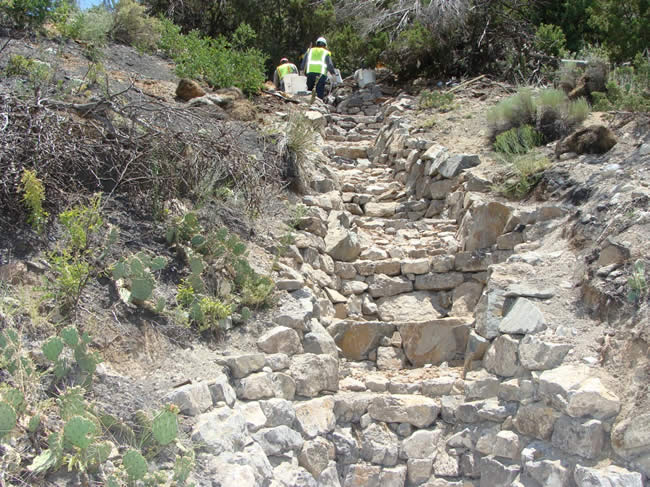
Hand-build “Zuni bowl” drop structures
Madrid Flood Repair Work Completed in October 2013
In October 2013, the Abandoned Mine Land (AML) Program completed repair work near local businesses and property in Madrid caused by flood damage that occurred from heavy rainstorms in September. Through a collaborative effort between the New Mexico Historic Preservation Division and the AML Program, the Mining and Minerals Division (MMD) was able to accelerate projects to address the recent flood damage.
“I am pleased that the Abandoned Mine Land Program was able to respond quickly to reduce the chances for further flood damage to historic and newer buildings in Madrid,” said Mining & Minerals Division Director Fernando Martinez. “Projects such as this demonstrate the Mining and Minerals Division’s commitment to protect public health and safety and property at abandoned mine sites in New Mexico.”
Rain runoff from an old coal mine waste pile had led to significant damage in the historic mining town. Contractors under the direction of the Mining & Minerals Division worked on the east slope of town to remove the slurry of coal gob (coal and other mineral by-products from coal mining.) Workers installed earthen berms and precast concrete Jersey barriers to serve as temporary storm water diversion measures. Crews also resurfaced driveways and land with base course (gravel) surfacing to make roadways accessible and to carry storm water downhill.
The temporary improvements to minimize further storm damage by water run-off were federally funded by the Office of Surface Mining Control and Reclamation Enforcement (OSM) through the state’s AML Program and cost $96,000.
A long-term, comprehensive plan is under development to address the effects of past coal mining practices on the east side of Madrid, where the adverse impacts from historic mining are greatest in the community. The AML Program proposes to stabilize hill slopes and drainages and direct storm flows away from homes and businesses.
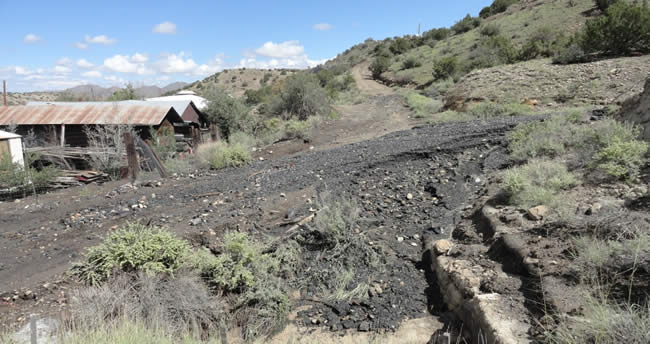
Post-storm gob slurry as seen following the September 2013 storms
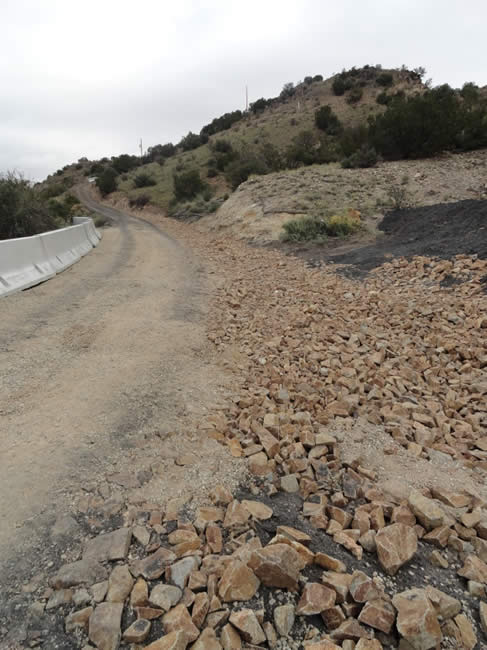
Improvements implemented under the direction of the AML Program
